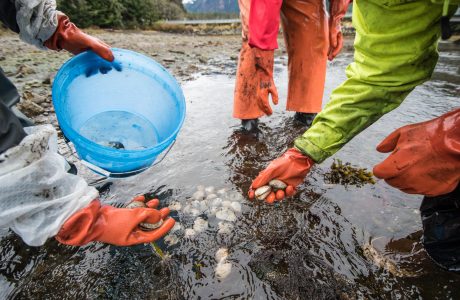
Alaska Natives rely on a variety of marine resources, including shellfish, as part of their traditional or subsistence diet. Shellfish are filter-feeders that can take up toxins produced by harmful algal bloom (HAB) species. These toxins can accumulate in shellfish varying anywhere from undetectable to lethal levels. Consumption of toxic shellfish in these regions after subsistence and recreational harvest present risks to human health, including paralysis and death.
Currently, the abundance and distribution of HAB toxins is not readily monitored in many regions of Alaska. Through the following combined efforts, NCCOS has supported Alaska Natives in building a monitoring network for algal toxins in their subsistence, traditional, and recreational shellfish harvests.
NCCOS is a long-time partner of Southeast Alaska Tribal Ocean Research (SEATOR), formed in 2013 to unify Alaska tribes in monitoring HAB events. SEATOR now includes 16 tribal governments and monitors over 52 sites weekly, using sampling techniques and toxin analysis methods developed and transferred from NCCOS and our Phytoplankton Monitoring Network. NCCOS continues to provide training and support to tribal monitors via annual HAB workshops.
Shellfish samples collected by the members of the SEATOR network are sent to the Sitka Tribe of Alaska Environmental Research Laboratory (STAERL) for analysis. Results of toxin analyses are then communicated to tribal partners to inform decisions regarding consumption of these food resources. Training STAERL personnel in shellfish toxin analysis was part of a multi-year NCCOS project funded by the EPA Indian General Assistance Program and the Administration for Native Americans – Environmental Regulatory Enhancement Program.
In summer 2018, an active bloom led to elevated toxin concentrations at these routine testing sites. Increased monitoring by STAERL was funded through NCCOS’ HAB Event Response program.
The NCCOS Monitoring and Event Response for Harmful Algal Blooms (MERHAB) program funded a collaborative project to expand SEATOR’s capabilities to test for additional toxins and to validate a new toxin detection method in 2019. Partners include scientists at NCCOS, Washington Sea Grant, and NOAA’s Northwest Fisheries Science Center. The MERHAB project aims to expand the toxin detection capabilities of the STAERL regional laboratory.
In Southwest Alaska, unusually warm ocean temperatures during summer 2020 increased the likelihood of HABs. In response, NCCOS has provided HAB Event Response funding to four Alaskan Native tribes along the Aleutian and Pribilof Islands, to temporarily support the expansion of regular and consistent shellfish toxin testing. Samples are being sent to the Alaska Department of Environmental Conservation Laboratory (ADEC) to test for HAB toxins.
Supporting safe seafood harvests as well as investments in the development of tools for detecting harmful algal blooms are significant NOAA contributions to demonstrating leadership in the Blue Economy.
